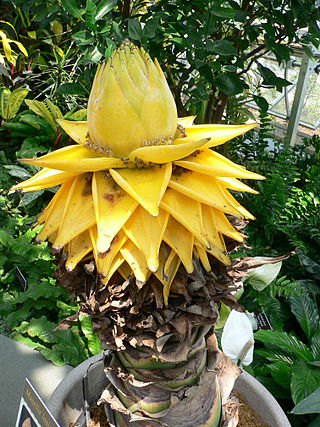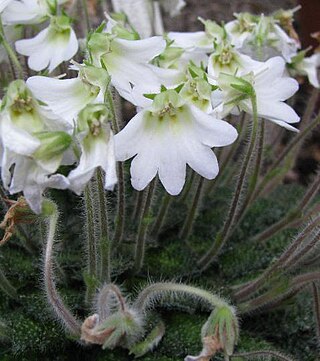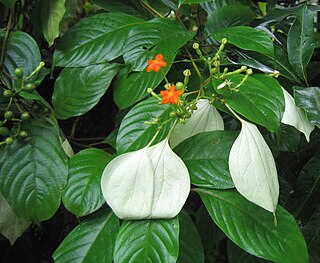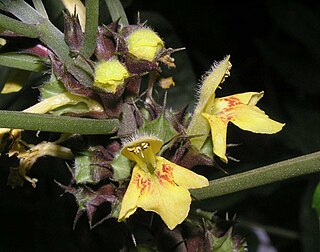
Dracocephalum is a genus of flowering plants in the family Lamiaceae, native to temperate regions of the Northern Hemisphere. These flowers, collectively called dragonhead, are annual or perennial herbaceous plants or subshrubs, growing to 15 to 90 centimeters tall. The genus has 89 species as currently circumscribed, which includes the formerly separate genera Hyssopus, Lallemantia, and others. Older circumscriptions include 60 to 70 species.

Pogostemon is a large genus from the family Lamiaceae, first described as a genus in 1815. It is native to warmer parts of Asia, Africa, and Australia.

Stewartia is a genus of 8-20 species of flowering plants in the family Theaceae, related to Camellia. Most of the species are native to eastern Asia in China, Japan, Korea, Laos, Myanmar, Thailand, and Vietnam, with two in southeast North America, from Virginia and Kentucky south to Florida and Louisiana.

Musella lasiocarpa, commonly known as Chinese dwarf banana, golden lotus banana or Chinese yellow banana, is the sole species in the genus Musella. It is thus a close relative of bananas, and also a member of the family Musaceae.

Tetrastigma is a genus of plants in the grape family, Vitaceae. The plants are lianas that climb with tendrils and have palmately compound leaves. Plants are dioecious, with separate male and female plants; female flowers are characterized by their four-lobed stigmas. The species are found in subtropical and tropical regions of Asia, Malaysia, and Australia, where they grow in primary rainforest, gallery forest and monsoon forest and moister woodland. Species of this genus are notable as being the sole hosts of parasitic plants in the family Rafflesiaceae, one of which, Rafflesia arnoldii, produces the largest single flower in the world. Tetrastigma is the donor species for horizontal gene transfer to Sapria and Rafflesia due to multiple gene theft events.
Hemipilia camptoceras is a species of plant in the family Orchidaceae. It is endemic to the Sichuan region of China.

Polyalthia is a genus of flowering plants in the family Annonaceae. There are approximately 90 species distributed from Africa to Asia and the Pacific.

Vincetoxicum is a genus of plants in the family Apocynaceae. Although the species in Vincetoxicum have sometimes been included in Cynanchum, chemical and molecular evidence shows that Vincetoxicum is more closely related to Tylophora, now included in Vincetoxicum. The generic name means "poison-beater" in Botanical Latin because of the plants' supposed antidotal effects against snakebite.

Petrocosmea is a genus of the family Gesneriaceae, the African violet family. Many of the species within this genus are endemic to high-elevation areas in Western China, although some are native to other parts of Asia. including north-central and southern China, Indochina, and the eastern Himalayas. It is a rosette-forming genus that generally grows on wet mossy rocks or forests.

Desmos is a genus of plants in the custard apple family Annonaceae, native to areas from India and China, through tropical Asia to northern Australia.

Mussaenda is a genus of flowering plants in the family Rubiaceae. They are native to the African and Asian tropics and subtropics. Several species are cultivated as ornamental plants.
Hanceola is a genus of flowering plants in the mint family, Lamiaceae, first described with this name in 1929. The entire genus is endemic to China.
- Hanceola cavaleriei(H.Lév.) Kudô - Guizhou
- Hanceola cordivataY.Z.Sun - Guizhou, Sichuan
- Hanceola exsertaY.Z.Sun ex C.Y.Wu - Fujian, Guangdong, Hunan, Jiangxi, Zhejiang
- Hanceola flexuosaC.Y.Wu & H.W.Li - Guangxi
- Hanceola labordei(H.Lév.) Y.Z.Sun - Guizhou
- Hanceola mairei(H.Lév.) Y.Z.Sun - Yunnan
- Hanceola sinensis(Hemsl.) Kudô - Guangxi, Guizhou, Hunan, Sichuan, Yunnan
- Hanceola tuberiferaY.Z.Sun ex G.Y.Wu - Sichuan
Microtoena is a genus of flowering plants in the mint family, Lamiaceae, first described in 1889. It is native to eastern and southeastern Asia, primarily China.
- Microtoena albescensC.Y.Wu & S.J.Hsuan - Guizhou
- Microtoena bhutanicaStearn - Bhutan
- Microtoena coreanaH.Lév - Korea
- Microtoena delavayiPrain - Sichuan, Yunnan
- Microtoena esquiroliiH.Lév. - Yunnan, Guizhou, Guangxi
- Microtoena griffithiiPrain - Arunachal Pradesh, Bangladesh
- Microtoena insuavis(Hance) Prain ex Briq. - Thailand, Vietnam, Guangdong, Guizhou, Yunnan
- Microtoena longisepalaC.Y.Wu - Sichuan
- Microtoena maireanaHand.-Mazz. - Yunnan
- Microtoena megacalyxC.Y.Wu - Guizhou, Yunnan
- Microtoena miyiensisC.Y.Wu & H.W.Li - Sichuan
- Microtoena mollisH.Lév. - Guizhou, Yunnan, Guangxi
- Microtoena moupinensis(Franch.) Prain - Tibet, Sichuan
- Microtoena muliensisC.Y.Wu - Sichuan
- Microtoena nepalensisStearn - Nepal
- Microtoena omeiensisC.Y.Wu & S.J.Hsuan - Sichuan
- Microtoena patchoulii(C.B.Clarke ex Hook.f.) C.Y.Wu & S.J.Hsuan - from Yunnan + Nepal south to Java
- Microtoena paucifloraC.Y.Wu - Yunnan
- Microtoena praineanaDiels - Guizhou, Sichuan, Yunnan
- Microtoena robustaHemsl. - Sichuan, Hubei
- Microtoena stenocalyxC.Y.Wu & S.J.Hsuan - Yunnan
- Microtoena urticifoliaHemsl. - Hubei, Hunan
- Microtoena vanchingshanensisC.Y.Wu & S.J.Hsuan - Guizhou
- Microtoena wardiiStearn - Tibet, Bhutan, Arunachal Pradesh

Mosla is a genus of plants in the family Lamiaceae, first described as a genus in 1875. It is native to eastern Asia, the Himalayas, and southeastern Asia.
- Mosla bracteataDoan ex Suddee & A.J.Paton - Vietnam
- Mosla cavalerieiH.Lév.- Vietnam, Guangdong, Guangxi, Guizhou, Hubei, Jiangxi, Sichuan, Yunnan, Zhejiang
- Mosla chinensisMaxim. - Vietnam, Korea, Japan, Anhui, Fujian, Guangdong, Guangxi, Guizhou, Hubei, Hunan, Jiangsu, Jiangxi, Shandong, Sichuan, Taiwan, Zhejiang
- Mosla coreanaH.Lév. - Korea
- Mosla dianthera(Buch.-Ham. ex Roxb.) Maxim. - China, Japan, Korea, Ryukyu Islands, Kuril Islands, Primorye, Caucasus, Himalayas, Myanmar, Vietnam, Philippines, Sumatra
- Mosla exfoliata(C.Y.Wu) C.Y.Wu & H.W.Li - Sichuan
- Mosla hangchouensisMatsuda - Zhejiang
- Mosla japonica(Benth. ex Oliv.) Maxim. - Japan, Korea, Ryukyu Islands
- Mosla longibracteata(C.Y.Wu & S.J.Hsuan) C.Y.Wu & H.W.Li - Guangxi, Zhejiang
- Mosla longispica(C.Y.Wu) C.Y.Wu & H.W.Li - Jiangxi
- Mosla pauciflora(C.Y.Wu) C.Y.Wu & H.W.Li - Guizhou, Hubei, Sichuan
- Mosla punctulataNakai - Korea, Taiwan, Japan, China
- Mosla scabra(Thunb.) C.Y.Wu & H.W.Li - Vietnam, Korea, Japan, Ryukyu Islands, Anhui, Fujian, Gansu, Guangdong, Guangxi, Henan, Hubei, Hunan, Jiangsu, Jiangxi, Liaoning, Shaanxi, Sichuan, Taiwan, Zhejiang
- Mosla soochouensisMatsuda - Anhui, Jiangsu, Jiangxi, Zhejiang
- Mosla tamdaoensisPhuong - Vietnam

Paraphlomis is a genus of flowering plants in the mint family, Lamiaceae, first described in 1901. It is native to China, Himalayas, and Southeast Asia.

Genianthus is a genus of plants in the family Apocynaceae, first described as a genus in 1883. It is native to southern China, the Indian Subcontinent, and Southeast Asia.
Polyalthiopsis is a genus of plants in the family Annonaceae and tribe Miliuseae. Its native range is Tibet, China and Vietnam.
Hemsleya is a genus of flowering plants belonging to the family Cucurbitaceae.
Magnolia fulva is a species of flowering plant in the family Magnoliaceae, native to south-central China and Vietnam. It was first described, as Michelia fulva, in 1987.
Wangia is a genus of flowering plants in the family Annonaceae. It includes two species endemic to south-central China.













